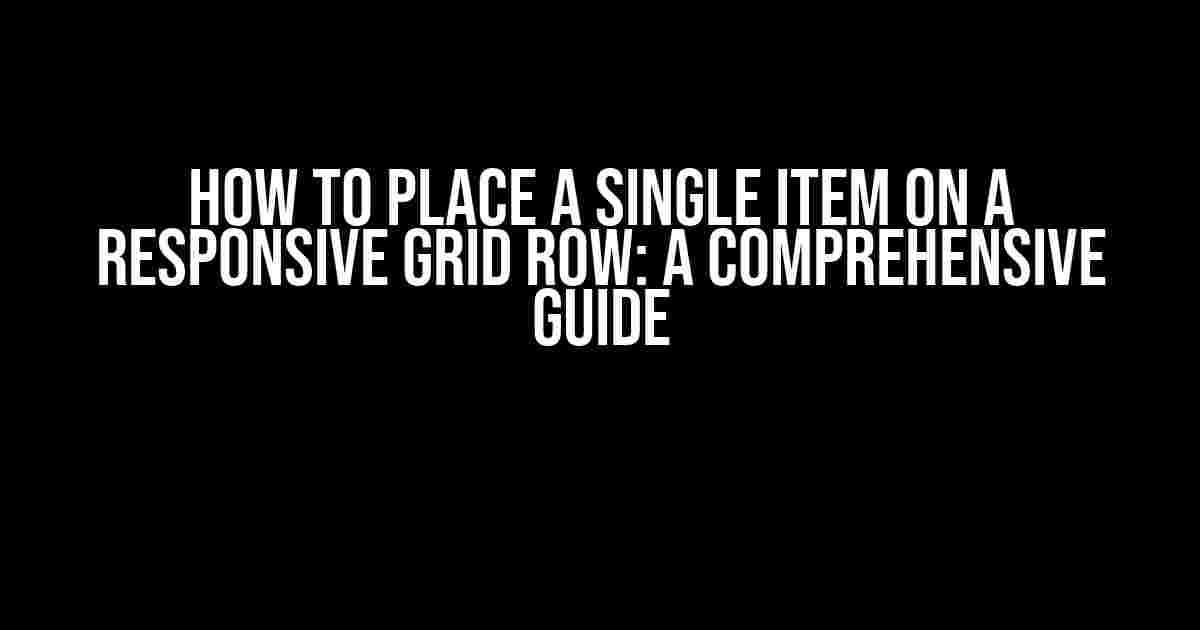Are you tired of struggling to place a single item on a responsive grid row? Do you find yourself getting frustrated with the endless trial and error of CSS styling? Well, worry no more! In this article, we’ll take you through a step-by-step guide on how to place a single item on a responsive grid row like a pro.
Understanding Responsive Grid Systems
Before we dive into the nitty-gritty of placing a single item on a responsive grid row, let’s take a quick look at what responsive grid systems are all about. A responsive grid system is a way of structuring content on a web page using a grid that adapts to different screen sizes and devices. This means that the grid will resize and reflow to fit the available space, ensuring that your content looks great on desktops, tablets, and mobile devices alike.
The Challenges of Placing a Single Item on a Responsive Grid Row
So, why is it so challenging to place a single item on a responsive grid row? The main issue lies in the fact that most grid systems are designed to handle multiple items per row, not single items. When you try to place a single item on a responsive grid row, it can end up looking like a lonely, lost puppy, stuck in the middle of nowhere.
This is because the grid system is trying to distribute the available space evenly, resulting in a single item taking up the entire row. Not exactly what we want, right? Fear not, dear reader, for we have some solutions up our sleeve.
Method 1: Using Grid Template Columns
One way to place a single item on a responsive grid row is to use grid template columns. This method involves defining a grid template with a single column, and then placing the item within that column.
.grid-container {
display: grid;
grid-template-columns: 1fr;
}
.grid-item {
grid-column: 1 / -1;
}
In the code above, we define a grid container with a single column using the `grid-template-columns` property. We then set the grid item to span the entire column using the `grid-column` property.
Pros and Cons of Using Grid Template Columns
Using grid template columns is a simple and effective way to place a single item on a responsive grid row. However, it does come with some limitations. For example, if you want to add more items to the grid later on, you’ll need to redefine the grid template columns.
| Pros | Cons |
|---|---|
| Simple to implement | Limited flexibility for future changes |
| Easy to maintain | May not work well with complex grid layouts |
Method 2: Using Grid Auto-Placement
Another way to place a single item on a responsive grid row is to use grid auto-placement. This method involves defining a grid container with multiple columns, and then letting the grid item automatically place itself within one of those columns.
.grid-container {
display: grid;
grid-template-columns: repeat(12, 1fr);
grid-auto-flow: column;
}
.grid-item {
grid-column: auto / span 1;
}
In the code above, we define a grid container with 12 columns using the `grid-template-columns` property. We then set the grid auto-flow to `column` and define the grid item to span a single column using the `grid-column` property.
Pros and Cons of Using Grid Auto-Placement
Using grid auto-placement is a great way to place a single item on a responsive grid row while maintaining flexibility for future changes. However, it can be more complex to implement than using grid template columns.
| Pros | Cons |
|---|---|
| More flexible than grid template columns | More complex to implement |
| Works well with complex grid layouts | May require more CSS styling |
Method 3: Using Flexbox
Another approach to placing a single item on a responsive grid row is to use flexbox. This method involves defining a flex container and setting the flex item to take up the full width of the container.
.flex-container {
display: flex;
flex-wrap: wrap;
}
.flex-item {
flex: 1 1 100%;
}
In the code above, we define a flex container with `display: flex` and set the flex item to take up the full width of the container using the `flex` property.
Pros and Cons of Using Flexbox
Using flexbox is a simple and effective way to place a single item on a responsive grid row. However, it may not work well with complex grid layouts.
| Pros | Cons |
|---|---|
| Easy to implement | May not work well with complex grid layouts |
| Works well for simple layouts | Limited flexibility for future changes |
Conclusion
And there you have it, folks! Three methods to place a single item on a responsive grid row. Whether you choose to use grid template columns, grid auto-placement, or flexbox, the key is to understand the strengths and weaknesses of each approach and choose the one that best fits your project needs.
Remember, the goal of responsive design is to create a seamless user experience across different devices and screen sizes. By mastering the art of placing single items on responsive grid rows, you’ll be well on your way to creating stunning, mobile-friendly designs that delight and engage your users.
Additional Resources
Want to learn more about responsive grid systems and single item placement? Check out these additional resources:
- CSS-Tricks: A Complete Guide to Grid
- MDN Web Docs: CSS Grid Layout
- Smashing Magazine: CSS Grid and Responsiveness
Happy coding, and don’t forget to share your own experiences and tips in the comments below!
Frequently Asked Question
Got a burning question about placing a single item on a responsive grid row? Well, you’re in luck! We’ve got the answers to your most pressing queries below.
Q1: How do I ensure my single item takes up the full width of the row?
Easy peasy! Simply add the class `grid-column: 1 / -1` to your item, and it will stretch to fill the entire row. This works because `grid-column` sets the start and end grid lines, and `-1` means the last grid line.
Q2: What if I want my item to be centered within the row?
No sweat! Just add `justify-self: center` to your item’s styles, and it will be neatly centered within the row. This works because `justify-self` controls how an item is positioned within its grid area.
Q3: Can I use flexbox instead of grid to achieve this?
Absolutely! You can use `flexbox` to create a single-item row. Just wrap your item in a container with `display: flex` and `justify-content: center`, and your item will be neatly centered. Alternatively, use `margin: 0 auto` to center the item horizontally.
Q4: What if I want to add some padding around my item?
Piece of cake! Just add `padding` to your item’s styles, and adjust the values to your liking. For example, `padding: 20px` will add 20 pixels of padding around your item. If you want to add padding only to the top or bottom, use `padding-top` or `padding-bottom` instead.
Q5: Can I use CSS grid to create a responsive layout for multiple items?
You bet! CSS grid is super powerful for creating responsive layouts. You can define multiple grid columns and rows, and use media queries to adjust the layout based on screen size. For example, you can use `grid-template-columns: repeat(3, 1fr)` to create a 3-column layout, and then use `@media` queries to change the layout to 2 columns on smaller screens.


